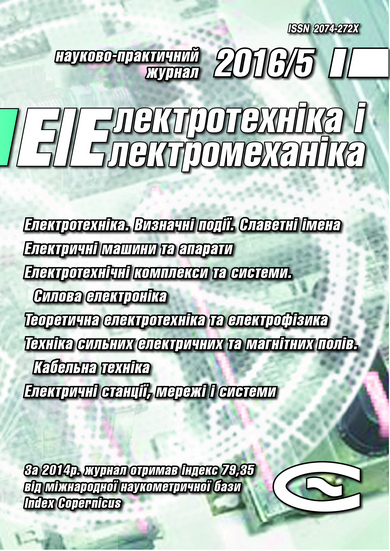EFFICIENCY EVALUATION TECHNIQUE OF THE SEMICONDUCTOR DC-DC CONVERTER APPLICATION IN THE POWER-SUPPLY SYSTEM
DOI:
https://doi.org/10.20998/2074-272X.2016.5.03Keywords:
semiconductor converter, efficiency of converter application, statistical modeling, evaluation of the effectiveness, converter efficiencyAbstract
Purpose. To specify efficiency evaluation of the DС-DC power semiconductor converter application in the power-supply system. Methodology. We have chosen application version of converter and then used the statistical modeling of DC-DC converter for its efficiency evaluation at varied input voltage according to proposed technique. We have compared the simulated result with the data presented in reference literature. Results. We have proposed the efficiency evaluation technique of converter application. Proposed technique includes detection of external factors influenced on the converter efficiency; development of efficiency evaluation models; selecting application version of converter; determination of the correlation coefficients between the values of external factors; definition of the converter efficiency; obtaining of the converter efficiency distribution. Originality. For the first time, we have developed the evaluation technique of converter efficiency corrected for application version of converter. Practical value. Presented in the study results could be useful for specialists in semiconductor equipment, electrical facilities and systems.References
1. Tittse U., Shenk K. Poluprovodnikovaja shemotehnika [Semiconductor engineering]. Moscow, Mir Publ., 1983. 512 p. (Rus).
2. Lukutin B.V., Obuhov S.G. Silovye preobrazovateli v elektrosnabzhenii [Power converters in electricity supply]. Tomsk, TPU Publ., 2007. 144 p. (Rus).
3. Gildersleeve M., Forghani-zadeh H.P., Rincon-Mora G.A. A Comprehensive Power Analysis and a Highly Efficient, Mode-Hopping DC-DC Converter. Proceedings. IEEE Asia-Pacific Conference on ASIC, September 2002, pp. 153-156. doi: 10.1109/apasic.2002.1031555.
4. Arvind Raj. Application Report. Calculating Efficiency. PMP-DCDC Controllers: SLVA390 – February 2010. – Available at: http://www.ti.com/lit/an/slva390/slva390.pdf (accessed September 28, 2015).
5. Chen M., Afridi K.K., Chakraborty S., Perreault D.J. A high-power-density wide-input-voltage-range isolated dc-dc converter having a MultiTrack architecture. 2015 IEEE Energy Conversion Congress and Exposition (ECCE), Sep. 2015. doi: 10.1109/ecce.2015.7309945.
6. Nowakowski R., Tang Ning. Efficiency of synchronous versus nonsynchronous buck converters. Texas Instruments Analog Applications Journal, 2009, no.4Q, pp. 15-18.
7. GOST 6962-75. Transport elektrificirovannyj s pitaniem ot kontaktnoj seti. Rjad naprjazhenij [State Standart 6962-75. Electrified transport with overhead system power supply. Voltage row]. Moscow, Izdatelstvo standartov Publ., 1975. 8 p. (Rus).
8. Larionova T.Y. Comparison of the auxiliary power supply systems of the electric railway rolling stock DC 3000 V according to the energy efficiency Transactions of Kremenchuk Mykhailo Ostrohradskyi National University, 2015, no.3(92), pp. 34-39. (Rus).
9. Katsikis V. MATLAB – A Fundamental Tool for Scientific Computing and Engineering Applications – Volume 1. InTech Publisher, 2012. 534 p. doi: 10.5772/2557.
10. Sigorskij V.P. Matematicheskij apparat inzhenera. Izd. 2-e. stereotip. [Engineer’s mathematical apparatus. 2nd ed. stereotype]. Kyiv, Tekhnika Publ., 1977. 786 p. (Rus).
Downloads
Published
How to Cite
Issue
Section
License
Copyright (c) 2016 M. A. Poliakov, T. Y. Larionova

This work is licensed under a Creative Commons Attribution-NonCommercial 4.0 International License.
Authors who publish with this journal agree to the following terms:
1. Authors retain copyright and grant the journal right of first publication with the work simultaneously licensed under a Creative Commons Attribution License that allows others to share the work with an acknowledgement of the work's authorship and initial publication in this journal.
2. Authors are able to enter into separate, additional contractual arrangements for the non-exclusive distribution of the journal's published version of the work (e.g., post it to an institutional repository or publish it in a book), with an acknowledgement of its initial publication in this journal.
3. Authors are permitted and encouraged to post their work online (e.g., in institutional repositories or on their website) prior to and during the submission process, as it can lead to productive exchanges, as well as earlier and greater citation of published work.





